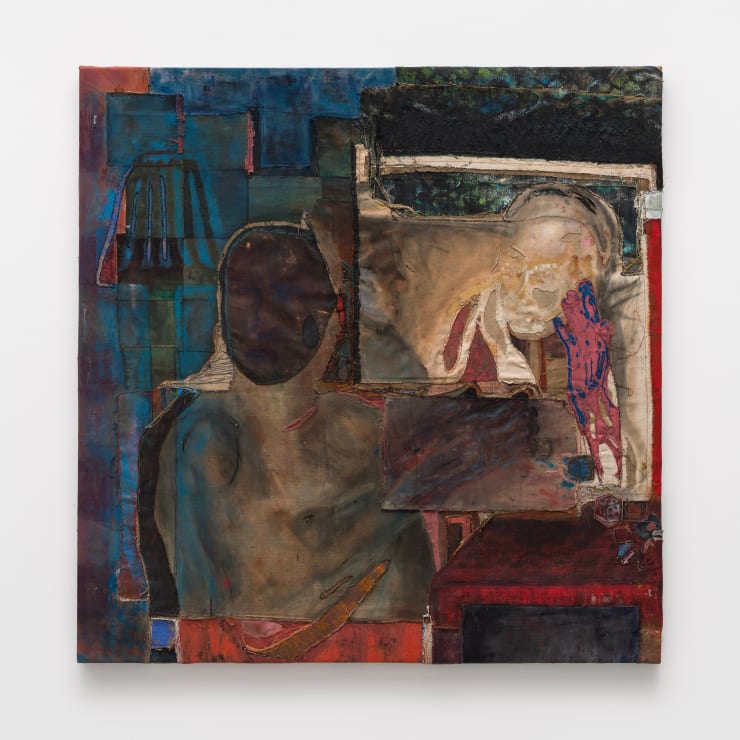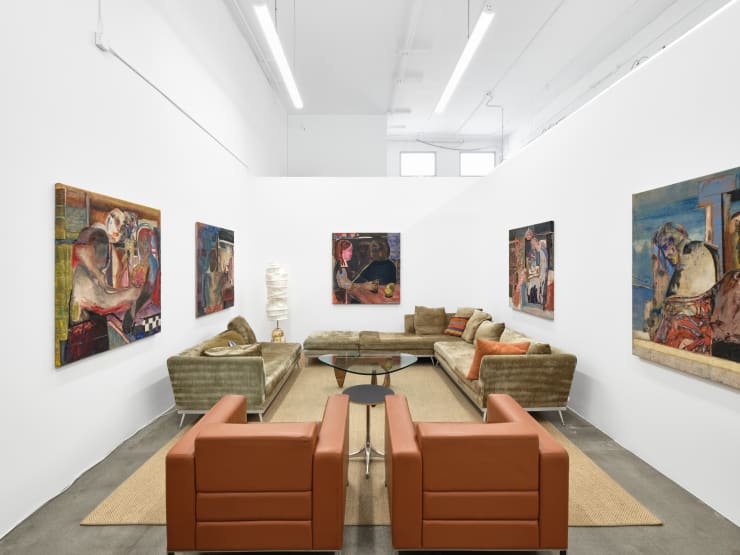G.V. Rodriguez
The commonplace subjects and restful mood in G.V. Rodriguez’s works are conduits for profane illuminations—lucid dreams imprinted, sewn, and painted into dense canvas and linen assemblages. Being a self-taught artist utilizing an unusual combination of processes, Rodriguez has created for himself an idiosyncratic figurative lexicon. His work is starkly reminiscent of 1840s Realism, where quotidian scenes were reconsidered for the power of their latent content. The surface exposes the depths. The essence must appear.
Realist master Gustave Courbet expressed latent psychological content through the hands of his subjects. In Rodriguez’s works too, hands often play a leading role in disclosing what faces conceal, as can be observed in most all of his works, namely Low Light, Big Red, Materia Medica, Fellow Feeling, The Charade, and Lights Out. But Rodriguez’s works are many sided, and even such potent guideposts as his figures’ hands are often only gateways into multifaceted narrative expositions.
Take Libra, for instance, in which a pondering face observes the five stars of the titular constellation, which themselves exist within the silhouetted profile of another face. The internal is externalized and internalized once more. The Charade too employs the positive and negative zones afforded by sewn fragments of canvas and linen to offer multiple echoes of the same scene, like discreet moments in time superimposed one upon the other. Both brooding figures are depicted in states of quiet composure and inward melancholy. In Lights Out, this strategy is exaggerated even more. The highly layered areas composing the right-hand figure’s torso and face reveal a density bordering on Expressionism, again synthesizing inner and outer states. This picture typifies the artist’s work: to turn out the lights so that one might truly see; to create from the sleeping silence of nothingness.
In Fellow Feeling, two boys compete for the romantic attention of a third figure, both offering bouquets of flowers. The rear figure is dislocated into three materials: the wrestled arm around the neck of the second boy, the monoprinted face, and the monoprinted hand at right. The heightened clarity of his face encourages the viewer to identify with him. The work can be read solipsistically. The beloved and the competition are projections of the rear figure’s respective desires and fears. Why else would the beloved’s face be so illegible if not for the fact that she does not yet exist. And should not the competition too, similarly stripped of identity, be merely an aspect of the central figure himself?
Surrealist writer and poet André Breton once wrote: “There can be no beauty at all, as far as I am concerned … except at the cost of affirming the reciprocal relations linking the object seen in its motion and in its repose.” Breton’s core imperative—to present an image in a coincidence of contradictory states—is at work in the dramaturgical psychology of Rodriguez’s figures. His paintings are narrative multiple exposures—his content as densely layered as his material practice. The quick outlines presented in this exhibition are little more than introductions to the psychological complexities persistent throughout the works. The subjects of Rodriguez’s paintings position themselves in the twilight zone between wakefulness and sleep. Within this liminal zone, authenticity and individuality become challenged. Beneath the prosaic patterns of daily life lies an ocean of psychological content. Ultimately unknowable in its full scope, it is rather glimpsed fleetingly through Rodriguez’s sewn shreds of canvas and linen. Treating the material of dreams with the same attention as the material of life, Rodriguez’s paintings bring the depths to the surface. The essence must appear.
-

-
 G.V. Rodriguez, Lights Out, 2022-23
G.V. Rodriguez, Lights Out, 2022-23 -
 G.V. Rodriguez, Fellow Feeling , 2022-23
G.V. Rodriguez, Fellow Feeling , 2022-23 -
 G.V. Rodriguez, Libra, 2022-23
G.V. Rodriguez, Libra, 2022-23 -
 G.V. Rodriguez, Tandem, 2022-23
G.V. Rodriguez, Tandem, 2022-23 -
 G.V. Rodriguez, The Charade, 2022-23
G.V. Rodriguez, The Charade, 2022-23 -
 G.V. Rodriguez, Materia Medica, 2022-23
G.V. Rodriguez, Materia Medica, 2022-23 -
 G.V. Rodriguez, Low Light, Big Red, 2022-23
G.V. Rodriguez, Low Light, Big Red, 2022-23 -
 G.V. Rodriguez, Scarlett Car, 2022
G.V. Rodriguez, Scarlett Car, 2022 -
 G.V. Rodriguez, Waiting, 2022
G.V. Rodriguez, Waiting, 2022 -
 G.V. Rodriguez, Two Step , 2022-23
G.V. Rodriguez, Two Step , 2022-23






















